This DIY cattle panel trellis creates an arch tunnel, and adds a magnificent architectural element to the garden. In this post I’ll give you the step by step instructions for how to make your own.
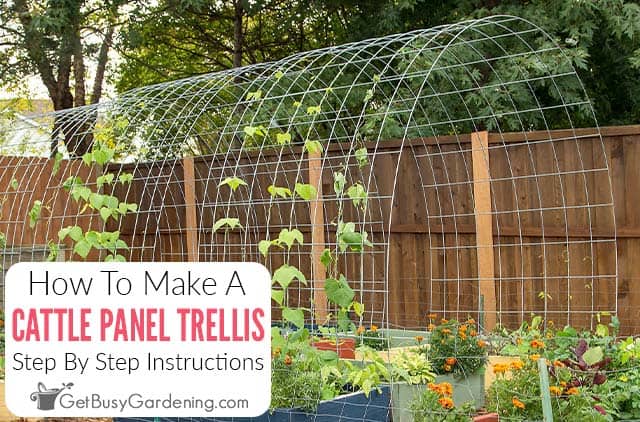
Arches are one of my favorite structures to use in my garden. Not only are they beautiful, they’re functional too because they can provide a huge amount of vertical growing space.
I made the large arch tunnel in my garden out of three panels of 4-gauge wire cattle fencing (also called livestock fencing), which is very thick.
The cattle panels create a strong trellis that can support large vining crops and other plants with ease.
It’s perfect for supporting heavy climbing plants like pole beans, melons, cucumbers, or squash. Use it to frame the entrance to your yard for dramatic appeal, or arch it over the top of a pathway to create shade and privacy.
You can make just one of these for your garden, or put a couple of them close together to create a lovely tunnel like mine.
Where To Buy Cattle Panels For A Trellis
You can find cattle panels for this trellis design at any farm supply store. One thing to keep in mind is that they are very large (16’ long), so plan accordingly when you go to pick them up.
I learned this the hard way when we showed up with a pickup truck to haul away the fencing, only to discover that the panels wouldn’t fit in the bed. We had to return later with a long trailer in order to bring them home.
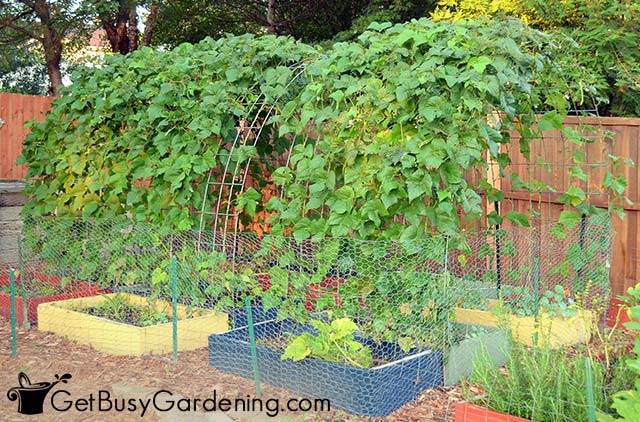
Cattle Panel Trellis FAQs
In this section, I’ll answer some of the most frequently asked questions about making a cattle panel trellis. If you can’t find yours here, then ask it in the comments below.
How far apart should cattle panel trellises be?
How far apart you put these cattle panel trellises depends on the space you have and your personal preference.
Mine are a few feet apart because I have them installed over my raised beds, and I wanted to be able to walk between them.
But you can put them right next to each other to create an unbroken tunnel, or space them further apart for more room to move around if you want.
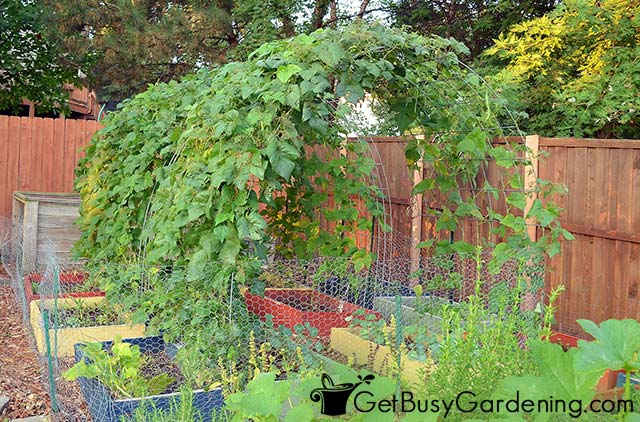
How do you arch cattle panels?
Arching cattle panels is definitely more difficult than is sounds, and you’ll need to have a partner help you with it. First, turn the panels so they are standing up horizontally on their side.
Then each person can grab onto one end, and walk towards each other until your arch is the shape and size you like.
You might find it easier to secure the ends with rope or a wire to make it less awkward to move into the garden.
How tall is a cattle panel arch trellis?
How tall your cattle panel arch trellis is depends on how much you want to bend it. The more you curve it, the taller it will be.
Some people even crimp the top so it’s in more of a cathedral arch shape, making it even taller. The ones in my garden are about 6′ tall.
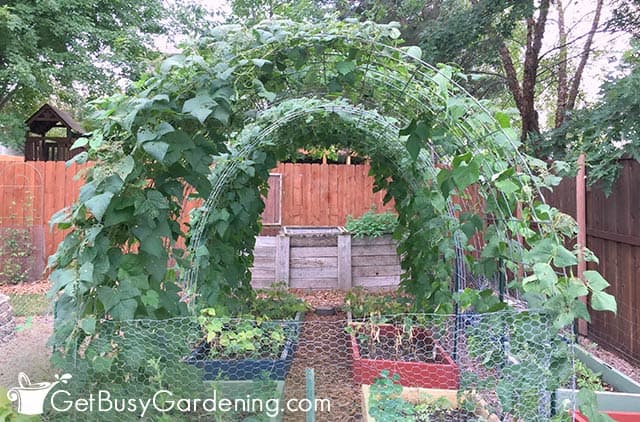
How To Make A Cattle Panel Trellis
Below are the step by step instructions for how to make a cattle panel trellis like mine. It’s really easy, and doesn’t take much time.
Cattle Panel Trellis Step-By-Step Instructions

You only need a few supplies to make this cattle panel trellis for your garden. Install it over your raised beds like I did, or anywhere else you have the space.
Materials
- 16’ x 50” 4 gauge wire cattle panel fencing (1)
- 9.5” heavy duty metal landscape stakes (8)
Tools
- Hammer
- Gloves
- Eye protection
Instructions
- Curve the cattle panel into an arch - Lay the cattle fencing piece on its side. Position one person at each end of the panel, and slowly walk towards each other to curve the panel into an arch shape. Stop when the ends of the panel are about 6’ apart.

- Install the trellis - Slowly turn the arch so that it’s standing up, then lift it into the garden, and position it into the location where you want it.

- Secure the trellis - Secure the bottom of the cattle panel trellis into the ground using four metal landscaping stakes on each side. Facing the tab of each stake toward the fencing, hammer the stakes into the ground at a slight angle. Once the landscaping stakes have been driven all the way into the ground, the metal tab of each stake should overlap the bottom piece of the fencing panel, ensuring the panel is completely secured to the ground.

Notes
- The panel fencing pieces are heavy, and very awkward to handle alone, so make sure you ask a friend to help you with this project.
- To stabilize this cattle panel trellis better, you could use 3' metal garden posts instead of landscaping stakes on the outside of the arches, and attach the fencing to the stakes using zip ties.
Making your own cattle panel trellis arch is easy and fun, and it will add a fantastic focal point in any garden area. I especially love the large tunnel I created in my veggie patch!
This is an excerpt from my book Vertical Vegetables. For more creative step by step DIY projects, and to learn all there is to know about growing vegetables vertically, order your copy now.
Or you can learn more about my Vertical Vegetables book here.
More DIY Projects You Might Like
Share your tips and ideas for making a cattle panel trellis in the comments section below.
Some of these photos were taken by Tracy Walsh Photography.
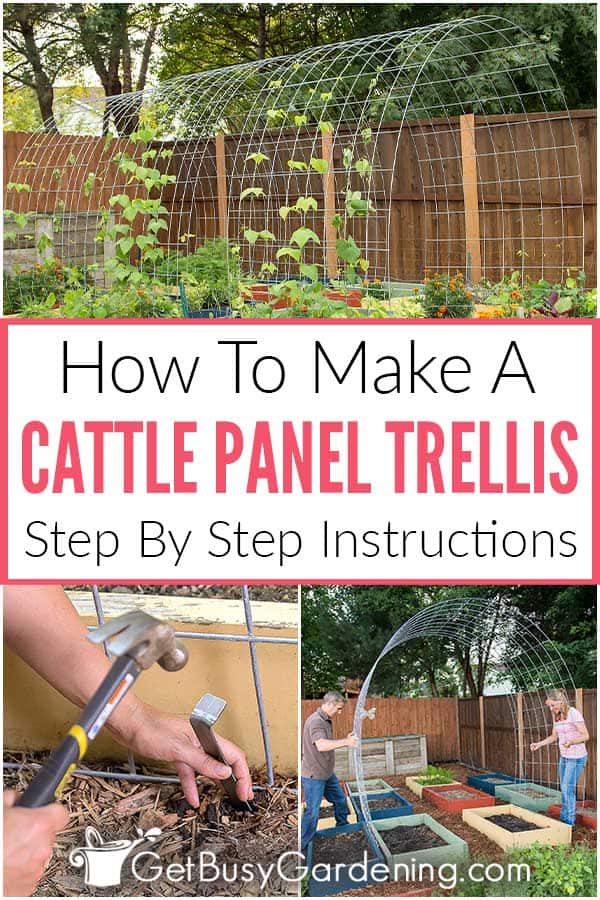
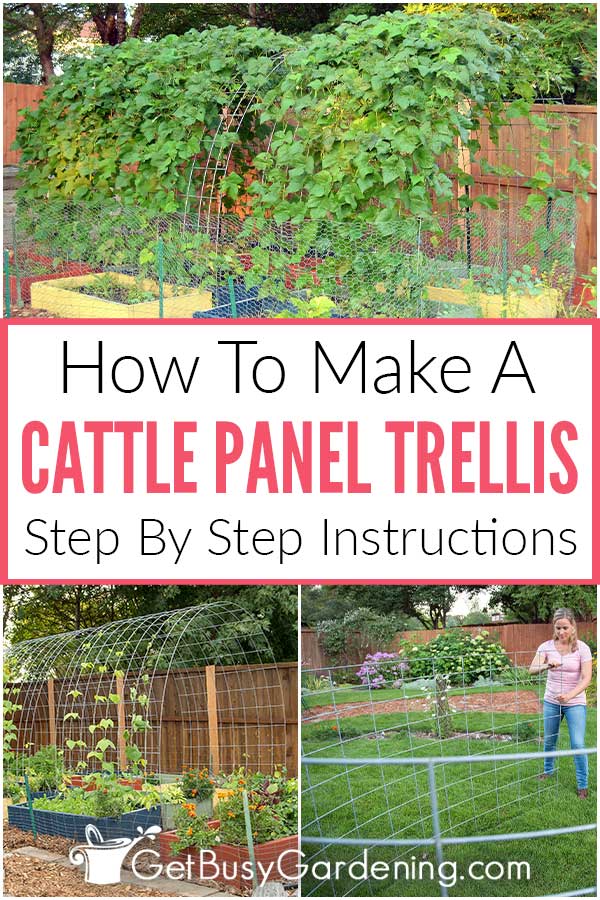
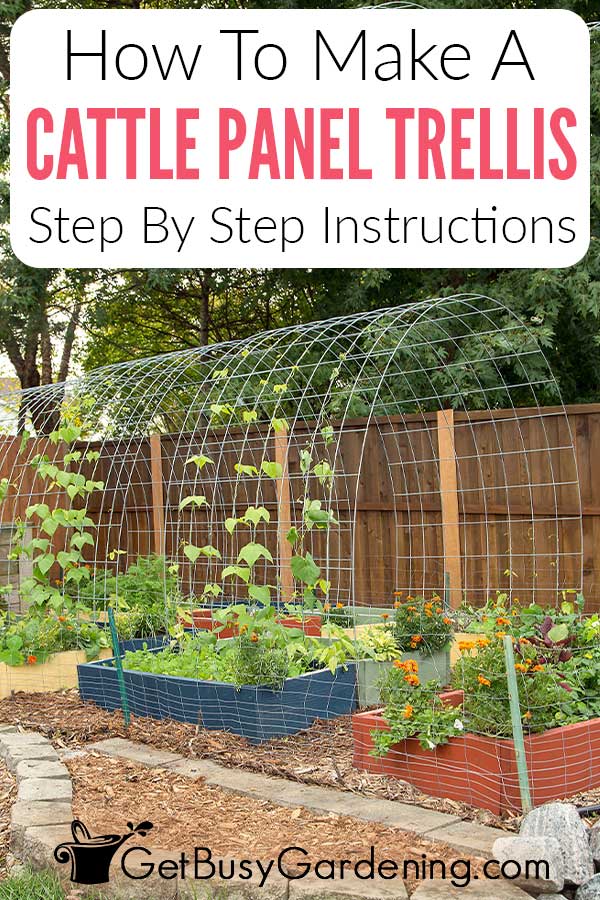

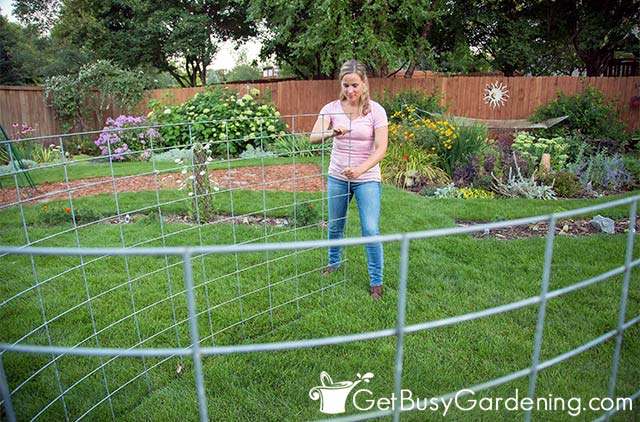
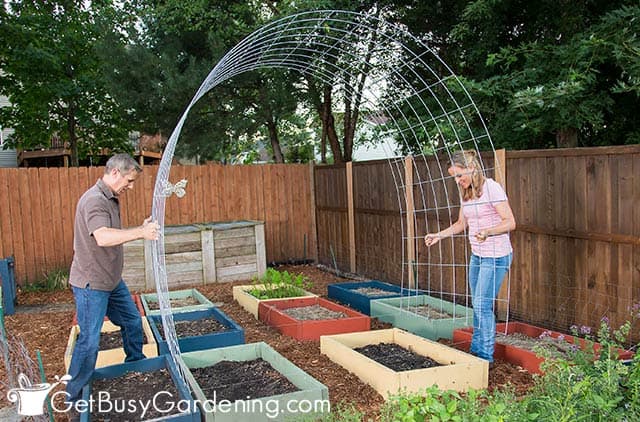
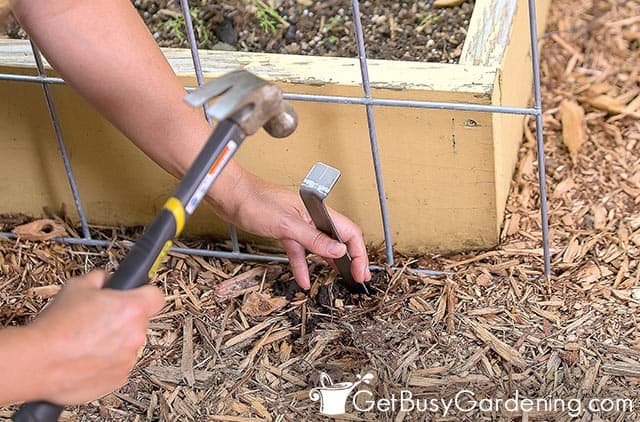


Cindi moore says
How could I make doors on the ends? Wanting to keep my dogs out of the garden.
Amy Andrychowicz says
I would just get some metal garden fencing that’s high enough to prevent the dogs from jumping over. Then run along the outside on each end of the cattle panel fencing, and use stakes to hold it in place.
Charlotte says
Does the trellis provide too much shade for the garden?
Amy Andrychowicz says
Once the cattle panel trellis is covered in vines, it will definitely provide shade underneath it.
Thomas A. Hutchings says
I’m not great at math. With a 16′ panel and 10′ at the base, how high is the centerpoint? Thank you.
Amy Andrychowicz says
If you make your cattle panel trellis arch 10′ wide, it wouldn’t be very tall, and it also wouldn’t be as strong as the one I built for this project. I recommend spacing the bottom ends of the arch no more than 6′ apart. Mine are 5′ apart, which created a 6′ tall arch.
Karen says
Would this be strong enough to use as a grape arbor?
Amy Andrychowicz says
Yes, this cattle panel trellis is strong enough for grapevines. But I recommend using the heavier duty stakes on each side to secure it well, since it will be a more permanent structure once the grapes become established.
Shelbi says
So I do strawbale gardening and was thinking of putting a couple cattle panels over my straw bales instead of doing the t posts and wire, as sometimes the plants get too tall for the wire to work. Would I need to remove the panels when winter comes? also would I need to rotate crops being that I am not growing in the ground?
Amy Andrychowicz says
You do not need to remove the panels for winter, they can stay in place year round. Crop rotation is always a good idea, but instead of moving the arch, you could just rotate the vining crops you plant in your straw bales each year.
Wei Luo says
I was inspired by the double arch trellis shown. I am especially interested on the larger, outside arch. What’s the largest arch trellis you have built using cattle panels? I am seriously considering building a 12′ wide one.
Amy Andrychowicz says
My cattle panel trellis is about 5′ wide at the base, and this is the only size I’ve built. There’s no way you would be able to build a 12′ wide one because the panels are only 16′ long. If you want something that’s 12′ wide, you would have to custom build it out of a different and much stronger type of metal, or the middle would sag.
RobertB says
Cattle panels are just over 4 feet tall. So make three arches and put them side-by-side and you’ll have about 12.5′ wide. If 12 feet is the max size, cut one row off of two of the panels. (they are hard to cut; use big bolt cutters, an angle grinder with a cutoff wheel, or a Sawzall, etc) HTH 🙂
Sharon says
When you walk through the tunnel, are you walking north to south or east to west?
Amy Andrychowicz says
My cattle panel trellis tunnel is facing north/south.
Elaine Harrison says
I love this idea and would love to have one by my gate. I need to span a 5 ft wide gate. So if using a 16’ cattle panel yours were 6 feet tall, I’m wondering how wide the trellis is?
Amy Andrychowicz says
My cattle panel trellises are about 5′ wide at the base.
Don Montgonery says
They come in 4’ or 5’ widths
LeOla says
Would these support kiwi plants?
Amy Andrychowicz says
Yes, cattle panels make very strong trellises that will support any type of heavy vine.
Brook says
Looks like it could be covered with plastic for a temporary greenhouse to get everything started in too
Amy Andrychowicz says
Yes, you could certainly use this cattle panel trellis for that!
RobertB says
Years ago, I bought some cattle panels and hauled them home from Fleet Farm in a longbed pickup. But I don’t remember how I did it, and I want to get some more. I don’t have a trailer. I either put the tailgate down and let the panels hang 6′ out the back of the bed (put a little red flag on the back and something really heavy on the front to keep them stable), or I put the tailgate up and draped them over the cab and tied them down front and back.
What about taking some bolt cutters to the farm store and cutting the panels in half? It’ll have to be *big* cutters because 4-gauge wire is tough. When setting up the trellis make a triangle, tying the top ends together with some wire or poly bailing twine. Then put a couple of boards maybe 2 feet down from the top for spreaders to make it cathedral or gothic shaped instead of a triangle. One person could probably handle it that way, and it would store a lot easier when you break them down for the winter.
Amy Andrychowicz says
Sure, it sounds like a good plan to me. I personally have only made the cattle panel trellis into an arch as I detailed in this tutorial, but it’s fun to come up with your own unique design! 🙂
Patricia Miller says
I saw a person on YouTube that bent them individually starting horizontal put one end into PU bed, take other end and bend it into bed on the opposite side, shut the tailgate after you load all panels and they will not move til you get them home..
Erika says
Wondering about how much this limits what goes on the inner beds. Do you plant mostly things needing some shade? Any advice for accounting for and planning for that?
Amy Andrychowicz says
Yes, I plant all of my shade-loving crops under the arches – like salad greens and such, herbs can also do very well under there. The extra shade that the arch provides is the perfect spot for other veggies that don’t like the hot sun, and can even help to slow their bolting.
Michelle says
Do you plant on the inside or the outside of the trellis
Amy Andrychowicz says
You can plant on either side, it doesn’t matter. The vines will find their way up either way.
Jacki says
Did you cut 16 foot in half?
Amy Andrychowicz says
No, not for the arch.
Lara says
I’m confused about the height. How does a 6′ panel arch over a 6′ bed, and still be roughly 6′ high. Is it two panels connected?
My tractor supply only goes up to 10′ panels, and I feel like they won’t be high enough after I arch them across my 6′ bed.
Amy Andrychowicz says
The cattle panels I used are 16’ long.
Lara says
That makes sense. I should have deduced that. 🤨
The list of materials says 6′ cattle panel. Thank you! Planning to do this next weekend!
Amy Andrychowicz says
Oops, that was a typo in the instructions, thanks for pointing it out. Fixed it. 🙂 Enjoy building yours, it’s awesome!
Mithershoe says
Love this idea. My panels of chicken wire stapled to 4′ x 8′ lath framing , on the horizontal, are not tall enough for the peas. Can’t stand them up to the 8′ height as they’re too unstable in wind, no matter the staking. So I would like to these. Do you move them from year to year for crop rotation? Or do you simply erect more panels?
Amy Andrychowicz says
My garden is too small to move my cattle panel trellises, so they stay put. I do rotate the type of crops I grow on them every year. I have 3 of these arches in my garden, so I can easily switch things up. It wouldn’t be difficult to move them though, if that’s what you want to do. You’ll just need a little help from a friend. 🙂